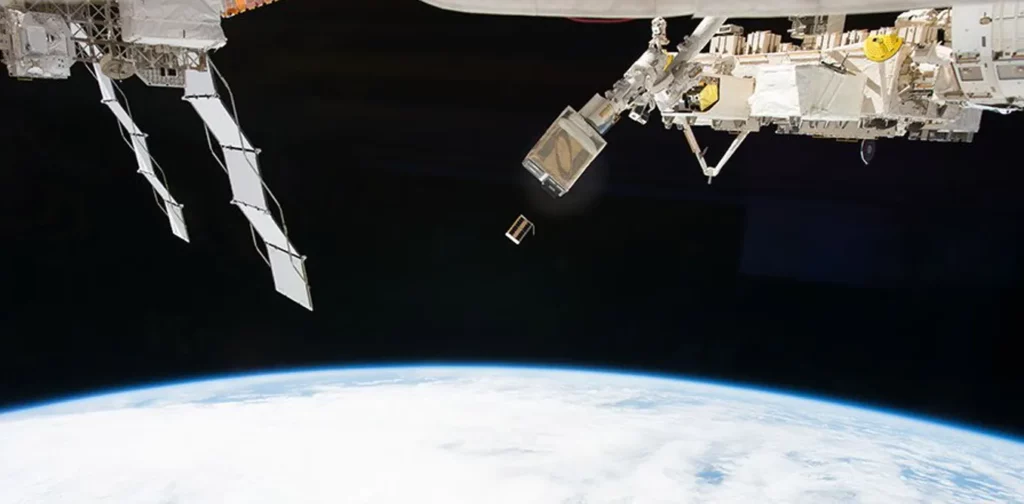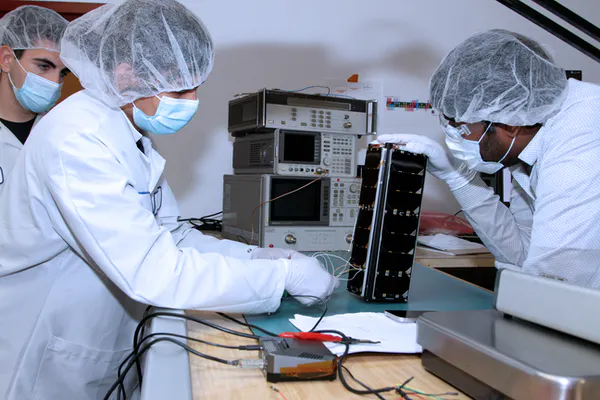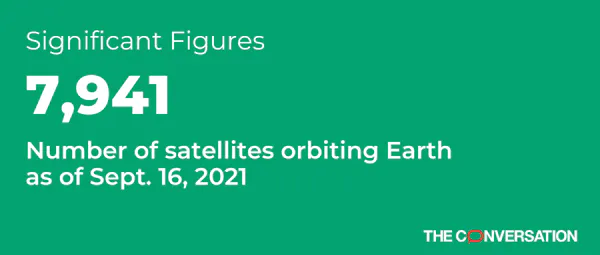How Many Satellites Are Orbiting Earth?
IN FOCUS, 20 Sep 2021
Supriya Chakrabarti | The Conversation - TRANSCEND Media Service

Thousands of the satellites orbiting Earth are small – like this cubical satellite seen here being released from the International Space Station. NASA, CC BY-NC
17 Sep 2021 – It seems like every week, another rocket is launched into space carrying rovers to Mars, tourists or, most commonly, satellites. The idea that “space is getting crowded” has been around for a few years now, but just how crowded is it? And how crowded is it going to get?
I am a professor of physics and director of the Center for Space Science and Technology at the University of Massachusetts, Lowell. Many satellites that were put into orbit have gone dead and burned up in the atmosphere, but thousands remain. Groups that track satellite launches don’t always report the same exact numbers, but the overall trend is clear – and astounding.
Since the Soviet Union launched Sputnik – the first human-made satellite – in 1957, humanity has steadily been putting more and more objects into orbit every year. Over the the second half of the 20th century, there was a slow but steady growth, with roughly 60 to 100 satellites launched yearly until the early 2010s.
But since then, the pace has been increasing dramatically.
By 2020, 114 launches carried around 1,300 satellites to space, surpassing the 1,000 new satellites per year mark for the first time. But no year in the past compares to 2021. As of Sept. 16, roughly 1,400 new satellites have already begun circling the Earth, and that will only increase as the year goes on. Just this week, SpaceX deployed another 51 Starlink satellites into orbit.

The ever-shrinking size of technology has led to tiny satellites like the one students are working on here.
Edwin Aguirre/University of Massachusetts Lowell, CC BY-ND
Small satellites, easy access to orbit
There are two main reasons for this exponential growth. First, it has never been easier to get a satellite into space. For example, on Aug. 29, 2021, a SpaceX rocket carried several satellites – including one built by my students – to the International Space Station. On Oct. 11, 2021, these satellites will deploy into orbit, and the number of satellites will increase again.
The second reason is that rockets can carry more satellites more easily – and cheaply – than ever before. This increase isn’t due to rockets getting more powerful. Rather, satellites have gotten smaller thanks to the electronics revolution. The vast majority – 94% – of all spacecraft launched in 2020 were smallsats – satellites that weigh less than around 1,320 pounds (600 kilograms).
The majority of these satellites are used for observing Earth or for communications and internet. With a goal of bringing the internet to underserved areas of the globe, two private companies, Starlink by SpaceX and OneWeb together launched almost 1,000 smallsats in 2020 alone. They are each planning to launch more than 40,000 satellites in the coming years to create what are called “mega-constellations” in low-Earth orbit.
Several other companies are eyeing this US$1 trillion market, most notably Amazon with its Project Kuiper .
httpv://www.youtube.com/watch?v=5h2t9Oyg2o0
A crowded sky
With the huge growth in satellites, fears of a crowded sky are starting to come true. A day after SpaceX launched its first 60 Starlink satellites, astronomers began to see them blocking out the stars. While the impact on visible astronomy is easy to understand, radio astronomers fear they may lose 70% sensitivity in certain frequencies due to interference from satellite megaconstellations like Starlink.
Experts have been studying and discussing the potential problems posed by these constellations and ways the satellite companies could address them . These include reducing the number and brightness of satellites, sharing their location and supporting better image-processing software.
As low-Earth orbit gets crowded, concern about space debris increases, as does a real possibility of collisions.
Future trends
Less than 10 years ago, the democratization of space was a goal yet to be realized. Now, with student projects on the Space Station and more than 105 countries having at least one satellite in space, one could argue that that goal is within reach.
Every disruptive technological advancement requires updates to the rules – or the creation of new ones. SpaceX has tested ways to lower the impact of Starlink constellations, and Amazon has disclosed plans to de-orbit their satellites within 355 days after mission completion. These and other actions by different stakeholders make me hopeful that commerce, science and human endeavors will find sustainable solutions to this potential crisis.
_________________________________________
 Supriya Chakrabarti – Professor of Physics, University of Massachusetts Lowell
Supriya Chakrabarti – Professor of Physics, University of Massachusetts Lowell
Go to Original – theconversation.com
Tags: Big tech, Cosmology, Earth, Militarism and science, Nuclear Arms in Space, Pollution, Satellites, Space Command, Space Debris, Space Digital Military Branch, Space Weapons, Space science, SpaceX
DISCLAIMER: The statements, views and opinions expressed in pieces republished here are solely those of the authors and do not necessarily represent those of TMS. In accordance with title 17 U.S.C. section 107, this material is distributed without profit to those who have expressed a prior interest in receiving the included information for research and educational purposes. TMS has no affiliation whatsoever with the originator of this article nor is TMS endorsed or sponsored by the originator. “GO TO ORIGINAL” links are provided as a convenience to our readers and allow for verification of authenticity. However, as originating pages are often updated by their originating host sites, the versions posted may not match the versions our readers view when clicking the “GO TO ORIGINAL” links. This site contains copyrighted material the use of which has not always been specifically authorized by the copyright owner. We are making such material available in our efforts to advance understanding of environmental, political, human rights, economic, democracy, scientific, and social justice issues, etc. We believe this constitutes a ‘fair use’ of any such copyrighted material as provided for in section 107 of the US Copyright Law. In accordance with Title 17 U.S.C. Section 107, the material on this site is distributed without profit to those who have expressed a prior interest in receiving the included information for research and educational purposes. For more information go to: http://www.law.cornell.edu/uscode/17/107.shtml. If you wish to use copyrighted material from this site for purposes of your own that go beyond ‘fair use’, you must obtain permission from the copyright owner.
